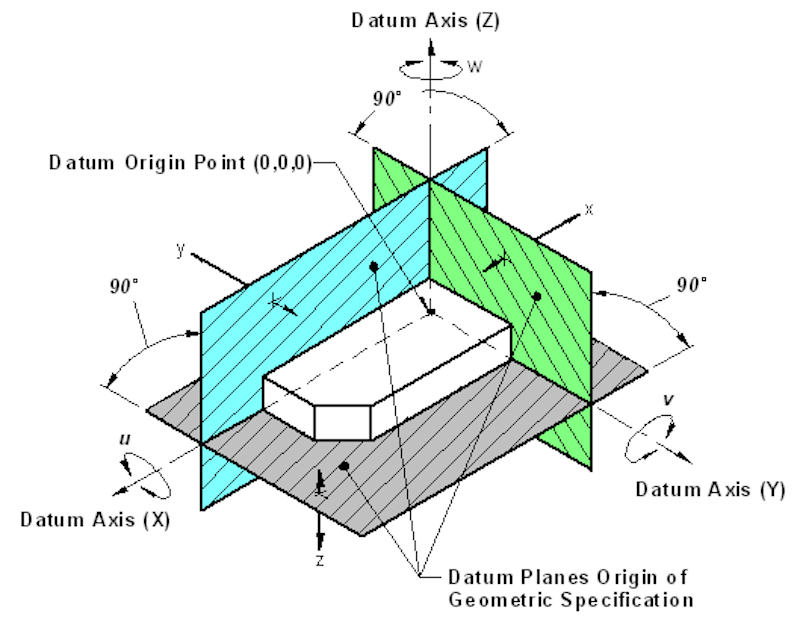The method of geometric dimensioning and tolerancing (GD&T) makes it possible to communicate technical design requirements precisely. The use of datums—points for measuring dimensions and tolerance specifications—is a crucial component of GD&T. This essay will analyze the idea of datums in GD&T, discuss their significance, and look at the several kinds that are crucial to guaranteeing reliable and reliable output.
Understanding datums in GD&T
Datums in GD&T consist of descriptive components used to establish the coordinate system and maintain geometric relationships between objects. These references serve as a basis for measurement and analysis and help to align and orient components during development and assembly.
Datums in GD&T: Types of Datums
Primary Datums
Primary datums are the first references specified in the GD&T control framework. They provide a preliminary basis for establishing a cohesive plan for a segment. The selection of primary datums is usually based on the functional requirements of the system and is critical to ensuring proper compatibility and integration of rapid maufacturing components.
Secondary datums
Secondary datums are additional contextual information used to refine the coordinate system established by the primary datums further. They play an important role in maintaining additional degrees of freedom and ensuring the geometric integrity of the whole part. The selection of the secondary datums depends on the specific tolerances and considerations required in the plan.
Third-level datums
Third-level datums are the third reference feature in the GD&T system. They are used when greater accuracy is required, usually for complex designs where tight tolerances must be maintained. Third-level datums help check fine details and deviations in the geometry of the part.
Important datums in GD&T

Consistent measurement
Datums provide an accurate and standardized location for measurement at various stages of construction. This ensures that the final product conforms to specified design requirements.
Setup and Assembly
The use of datums facilitates alignment and assembly during low volume manufacturing and production. This is critical to ensuring efficiency and effectiveness in the finished product.
Tolerance Management
Datums play an essential role in managing dimensional tolerances. By identifying points, GD&T allows engineers to communicate acceptable variations in size, style, and orientation within defined limits.
Easy of inspection
In quality control and inspection, datums simplify the process by providing a consistent basis for checking the conformity of the manufactured part to design specifications.
Datum in GD&T : Other information of interest
Datum Feature Simulators
Datum Feature Simulators are indispensable tools in the Geometric Dimensioning Tolerance (GD&T) inspection process, providing a visual and practical way to verify measurement accuracy. These simulators go beyond reproducing datum features. Just They actively contribute to the overall quality assurance process.
Datum in GD&T: Applications in real-world situations
Verification of functional relationships
Datam feature simulators not only simulate datum proximity but also help verify the functional relationships of various features on a part. This is especially important in complex systems where many interacting factors greatly influence the overall performance of the product. By using simulators to simulate these interactions, monitors can ensure that the intended working relationships are maintained.
Dynamic simulation of assemblies
The connections of datum features at different assemblies are sharp and critical for proper fit and alignment. Datum Feature Simulators, when designed to simulate assembly conditions, provide a realistic representation of how parts interact in the assembly process. This dynamic simulation ensures that designed parts do not meet individual tolerances, only loose alignment in the final product.
Adaptation to tolerance areas
Some systems may require specific consideration of tolerance zones, especially in areas where multiple factors come together. Datum-feature simulators can be constructed to test and verify measurements within these tight tolerance zones, allowing for a thorough analysis of the compliance of the part with design requirements.
Training programs to include in datum in GD&T

Interactive learning tools
The datum feature simulator is an interactive learning tool used to train operators involved in the survey process. The inclusion of these simulators in training programs provides individuals with hands-on experience, increasing their understanding of how datum features affect measurement. This practical approach offers skill development and proficiency in GD&T applications.
Crisis Preparation
Datum feature simulators provide a platform for creating problem-solving scenarios. Analysts can use these simulators to address potential problems that may arise when analyzing a fundamental part. This approach enables the development of practical solutions and strategies to solve challenges in real-world manufacturing.
Datum presentation frames
Datum reference frames represented by letters (A, B, C, etc.) form the backbone of Geometric Dimensioning Tolerance (GD&T) systems, providing more than method identification through detailed analysis of design concepts, manufacturing efficiencies, and their success in the realization of precise functional products impact is highlighted.
Datum in GD&T: Influence on Design Intent
Balancing Design Intent with Manufacturing Feasibility
Datum reference frames play an essential role in communicating design ideas but also affect the feasibility of products. Engineers must balance providing a clear and accurate datum reference frame with design requirements and ensuring that the construction team can achieve the specified tolerances and alignments.
Changes in design iteration in Datum in GD&T
The datum reference frame allows flexibility during design iteration. As engineers adjust and modify the system, they can adapt the datum system to change without having an overall understanding of the part coordinate system. This variation contributes to the repetitiveness of the design process, producing continuous improvement.
Datum in GD&T: Integration of Digital Engineering
Digital representation and simulation
In the age of digital technology, datum reference frames have been easily integrated into digital design tools and simulations. Digital representations of the datum hierarchy enable design communication and collaboration and allow real-time adjustments and visualization of the effects of tolerances and alignments.
Automated monitoring system
Datum reference frames play an important role in automated inspection systems. Using digital representations, software systems can run inspection processes, reducing manual effort and reducing the risk of human error. This integration enhances the efficiency of all quality control procedures in today's manufacturing facilities.
Considerations for Global Collaboration
Standardized Notation for Global Understanding
Datum reference frames, when standardized and observed internationally, contribute to global understanding and harmonization. Engineers and manufacturers across industries can easily interpret and apply mold design specifications, enhancing a consistent approach to GD&T and reducing the chances that errors will occur due to local changes in characters.
Digital data exchange
Datum reference frames are an essential part of digital data exchange between design and construction teams. Standardized digital stations facilitate the seamless transfer of information, ensuring that the standard datum system is communicated and understood, regardless of geographic location.
Conclusion
Datums in GD&T are crucial to achieving precision, accuracy, and quality in manufacturing. Together, primary, secondary, and tertiary data form a reliable reference framework that guides product development and research design. By understanding the importance of data and its quality, engineers can increase the accuracy and reliability of their designs, thereby improving productivity. Remember to consider datum feature simulators and reference frames as additional tools to ensure seamless implementation of GD&T.
TEAM MFG applies good tolearnce in our rapid prototyping services, CNC machining services, injection molding services and die casting. Contact us today!





















